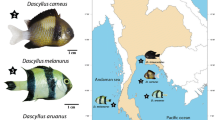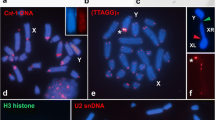Abstract
A common placement for most sex chromosomes that is involved in their evolutionary histories is the accumulation of distinct classes of repetitive DNAs. Here, with the aim of understanding the poorly studied repetitive DNA organization in crickets and its possible role in sex chromosome differentiation, we characterized the chromosomes of the cricket species Cycloptiloides americanus, a species with the remarkable presence of the unusual sex chromosome system X1X20♂/X1X1X2X2♀. For these proposes, we used C-banding and mapping through the fluorescence in situ hybridization of some repetitive DNAs. The C-banding and distribution of highly and moderately repetitive DNAs (C 0t-1 DNA) varied depending of the chromosome. The greater accumulation of repetitive DNAs in the X2 chromosome was evidenced. The microsatellites were spread along entire chromosomes, but (AG)10 and (TAA)10 were less enriched, mainly in the centromeric areas. Among the multigene families, the 18S rDNA was spread throughout almost all of the chromosomes, except for pair 5 and X2, while the U2 snDNA was placed exclusively in the largest chromosome. Finally, the 5S rDNA was exclusively located in the short arms of the sex chromosomes. The obtained data reinforce the importance of chromosomal dissociation and inversion as a primary evolutionary mechanism to generate neo-sex chromosomes in the species studied, followed by the repetitive DNAs accumulation. Moreover the exclusive placement of 5S rDNA in the sex chromosomes suggests the involvement of this sequence in sex chromosome recognition throughout meiosis and, consequently, their maintenance, in addition to their avoiding degeneration.




Similar content being viewed by others
References
Araujo D, Schneider MC, Paula-Neto E, Cella DM (2012) Sex chromosomes and meiosis in spiders: a review. In: Swan A (ed) Meiosis-molecular mechanisms and cytogenetic diversity. Intech, Rijeka, pp 87–108
Bidau CJ, Martí DA (2001) Meiosis and the Neo-XY of Dichroplus vittatus (Melanoplinae, Acrididae): a comparison between sexes. Genetica 110:185–194
Bueno D, Palacios-Gimenez OM, Cabral-de-Mello DC (2013) Chromosomal mapping of repetitive DNAs in Abracris flavolineata reveal possible ancestry for the B chromosome and surprisingly H3 histone spreading. PLoS One 8:e66532
Cabral-de-Mello DC, Moura RC, Martins C (2010) Chromosomal mapping of repetitive DNAs in the beetle Dichotomius geminatus provides the first evidence for an association of 5S rRNA and histone H3 genes in insects, and repetitive DNA similarity between the B chromosome and A complement. Heredity 104:393–400
Cabral-de-Mello DC, Oliveira SG, Moura RC, Martins C (2011) Chromosomal organization of the 18S and 5S rRNAs and histone H3 genes in Scarabaeinae coleopterans: insights into the evolutionary dynamics of multigene families and heterochromatin. BMC Genet 12:88
Cabrero J, Camacho JPM (1986) Cytogenetic studies in gomphocerine grasshoppers I. Comparative analysis of chromosome C-banding pattern. Heredity 56:365–372
Cabrero J, Camacho JP (2008) Location and expression of ribosomal RNA genes in grasshoppers: abundance of silent and cryptic loci. Chromosome Res 16:595–607
Castillo ER, Martí DA, Bidau CJ (2010) Sex and neo-sex chromosomes in Orthoptera: a review. J Orthopt Res 19:213–231
Charlesworth B, Sniegowski P, Stephan W (1994) The evolutionary dynamics of repetitive DNA in eukaryotes. Nature 371:215–220
Charlesworth D, Charlesworth B, Marais G (2005) Steps in the evolution of heteromorphic sex chromosomes. Heredity 95:118–128
del Cerro AL, Cunãdo N, Santos JL (1998) Synaptonemal complex analysis of the X1X2Y trivalent in Mantis religiosa L. males: inferences on the origin and maintenance of the sex-determining mechanism. Chromosome Res 6:5–11
Forman M, Nguyen P, Hula V, Král J (2013) Sex chromosome pairing and extensive NOR polymorphism in Wadicosa fidelis (Araneae: Lycosidae). Cytogenet Genome Res 141:43–49
Hanson RE, Islam-Faridi MN, Percival EA et al (1996) Distribution of 5S and 18S-28S rDNA loci in a tetraploid cotton (Gossypium hirsutum L.) and its putative diploid ancestors. Chromosoma 105:55–61
Heitz E (1935) Die Herkunft der Chromozentren. Planta 18:571–635
Hewitt GM (1979) Grasshoppers and crickets. Animal cytogenetics: insecta 1 Orthoptera, vol 3. Gebrüder Borntraeger, Berlin
Hughes-Schrader S (1947) Reversion of X0 to XY sex chromosome mechanism in a phasmid. Chromosoma 3:57–65
Ijdo JW, Wells RA, Baldini A, Reeders ST (1991) Improved telomere detection using a telomere repeat probe (TTAGGG)n generated by PCR. Nucleic Acids Res 19:4780
John B, King M (1985) The inter-relationship between heterochromatin distribution and chiasma distribution. Genetica 66:183–194
Kaiser VB, Bachtrog D (2010) Evolutions of sex chromosome in insects. Annu Rev Genet 44:91–112
Kejnovsky E, Hobza R, Cermak T, Kubat Z, Vyskot B (2009) The role of repetitive DNA in structure and evolution of sex chromosomes in plants. Heredity 102:533–541
Kejnovský E, Michalovova M, Steflova P et al (2013) Expansion of microsatellites on evolutionary young Y chromosome. PLoS One 8:e45519
Kubat Z, Hobza R, Vyskot B, Kejnovsky E (2008) Microsatellite accumulation on the Y chromosome in Silene latifolia. Genome 51:350–356
Kusnetzova VG (1988) The unusual mechanism of sex-chromosome determination in the cotton bug Dysdercus superstitiosus F (Pyrrhocoridae, Heteroptera). Dokl Akad Nauk SSSR 301:456–458
Maddison WP, Leduc-Robert G (2013) Multiple origins of sex chromosome fusions correlated with chiasma localization in Habronattus jumping spiders (Araneae: Salticidae). Evolution 67:2272–2558
Matsubara K, Knopp T, Sarre SD, Georges A, Ezaz T (2013) Karyotypic analysis and FISH mapping of microsatellite motifs reveal highly differentiated XX/XY sex chromosomes in the pink-tailed worm-lizard (Aprasia parapulchella, Pygopodidae, Squamata). Mol Cytogenet 6:60
Matsunaga S (2009) Junk DNA promotes sex chromosome evolution. Heredity 102:525–526
Mesa A, de Mesa RS (1967) Complex sex-determining mechanisms in three species of South American grasshoppers (Orthoptera, Acridoidea). Chromosoma 21:163–180
Mesa A, García-Novo P (2001) Neometrypus badius a new species of cricket with an unusual sex determining mechanism (Grylloidea, Eneopteridae, Tafaliscinae, Neometrypini). J Orthopt Res 10:81–87
Mesa A, Ferreira A, Carbonell CS (1982) Cariología de los acridoideos neotropicales: estado actual de su conocimiento y nuevas contribuciones. Ann de la Société Entomologique de France (NS) 18:507–526
Mesa A, Fontanetti CS, García-Novo P (2001) Does an X-autosome centric fusion in Acrdoidea condemn the species to extinction? J Orthopt Res 10:141–146
Mesa A, García-novo P, dos Santos D (2002) X1X2O (male)-X1X1X2X2 (female) chromosomal sex determining mechanism in the cricket Cycloptiloides americanus (Orthoptera, Grylloidea, Mogoplistidae). J Orthopt Res 1:87–90
Milani D, Cabral-de-Mello DC (2014) Microsatellite organization in the grasshopper Abracris flavolineata (Orthoptera: Acrididae) revealed by FISH mapping: remarkable spreading in the A and B chromosomes. PLoS One 9:e97956
Morgan TH (1915) The predetermination of sex in Phylloxerans and Aphids. J Exp Zool 19:285–321
Nei M, Rooney AP (2005) Concerted and birth-and-death evolution of multigene families. Annu Rev Genet 39:121–152
Nguyen P, Sahara K, Yoshido A, Marec F (2010) Evolutionary dynamics of rDNA clusters on chromosomes of moths and butterflies (Lepidoptera). Genetica 138:343–354
Palacios-Gimenez OM, Castillo ER, Martí DA, Cabral-de-Mello DC (2013) Tracking the evolution of sex chromosome systems in Melanoplinae grasshoppers through chromosomal mapping of repetitive DNA sequences. BMC Evol Biol 13:167
Panzera Y, Pita S, Ferreiro MJ et al (2012) High dynamics of rDNA cluster location in kissing bug holocentric chromosomes (Triatominae, Heteroptera). Cytogenet Genome Res 138:56–67
Pinkel D, Straume T, Gray JW (1986) Cytogenetic analysis using quantitative, high-sensitivity, fluorescence hybridization. Proc Natl Acad Sci USA 83:2934–2938
Pokorná M, Kratochvíl L, Kejnovský E (2011) Microsatellite distribution on sex chromosomes at different stages of heteromorphism and heterochromatinization in two lizard species (Squamata: Eublepharidae: Coleonyx elegans and Lacertidae: Eremias velox). BMC Genet 12:90
Raskina O, Barber JC, Nevo E, Belyayev A (2008) Repetitive DNA and chromosomal rearrangements: speciation-related events in plant genomes. Cytogenet Genome Res 120:351–357
Sambrook J, Russel DW (2001) Molecular cloning. A laboratory manual, 3rd edn. Cold Spring Harbor Laboratory Press, New York
Santos JL, Arana P, Giráldez L (1983) Chromosome C-banding patterns in Spanish Acridoidea. Genetica 61:65–74
Schubert I (1984) Mobile nucleolus organizing regions (NORs) in Allium (Liliaceae S-Lat)-inferences from the specifity of silver staining. Plant Syst Evol 144:291–305
Schubert I, Wobus U (1985) In situ hybridization confirms jumping nucleolus organizing regions in Allium. Chromosoma 92:143–148
Schweizer D, Mendelak M, White MJD, Contreras N (1983) Cytogenetics of the parthenogenetic grasshopper Warramaba virgo and its bisexual relatives X. Pattern of fluorescent banding. Chromosoma 88:227–236
Steflova P, Tokan V, Vogel I et al (2013) Contrasting patterns of transposable element and satellite distribution on sex chromosomes (XY1Y2) in the dioecious plant Rumex acetosa. Genome Biol Evol 5:769–782
Steinemann S, Steinemann M (2005) Retroelements: tools for sex chromosome evolution. Cytogenet Genome Res 110:134–143
Steinemann M, Steinemann S, Lottspeich F (1993) How Y chromosomes become genetically inert. Proc Natl Acad Sci USA 90:5737–5741
Sumner AT (1972) A simple technique for demonstrating centromeric heterochromatin. Exp Cell Res 75:304–306
Terencio ML, Schneider CH, Gross MC et al (2013) Evolutionary dynamics of repetitive DNA in Semaprochilodus (Characiformes, Prochilodontidae): a fish model for sex chromosome differentiation. Sex Dev 7:325–333
Ueshima N (1979) Hemiptera II: Heteroptera. Animal cytogenetics 3: insecta 6. Gebrueder Borntraeger, Berlin
Utsunomia R, Scacchetti PC, Pansonato-Alves JC, Oliveira C, Foresti F (2014) Comparative chromosome mapping of U2 snRNA and 5S rRNA genes in Gymnotus species (Gymnotiformes, Gymnotidae): evolutionary dynamics and sex chromosome linkage in G. pantanal. Cytogenet Genome Res 142:286–292
Vítková M, Fukova I, Kubíčková S, Marec F (2007) Molecular divergence of the W chromosomes in pyralid moths (Lepidoptera). Chromosome Res 15:917–930
Walton AC (1924) Studies on nematode gametogenesis. Z Zell-u Gewebl 1:167–239
Webb GC, Westerman M (1978) G- and C-banding in the Australian grasshopper Phaulacridium vittatum. Heredity 41:131–136
Webb GC, White MJD, Contreras N, Cheney J (1978) Cytogenetics of the parthogenetic grasshopper Warramaba (formely Moraba) virgo and its bisexual relatives IV. Chromosome banding studies. Chromosoma 67:309–339
Westerman M, Hewitt GM (1985) Chromosome banding in Podisma pedestris. Heredity 55:157–161
White MJD (1940) The origin and evolution of multiple sex-chromosome mechanisms. J Genet 40:303–336
White MJD (1941) The evolution of the sex chromosomes I. The X0 and X1X2Y mechanisms in praying mantids. J Genet 42:143–172
White MJD (1969) Chromosomal rearrangement and speciation in animals. Ann Rev Genet 3:75–98
White MJD (1973) Animal cytology and evolution. Cambridge University Press, Cambridge
Zefa E, Redu DR, Costa MKM, Fontanetti CS, Gottschalk MS, Padilha GB, Silva AF, Martins LP (2014) A new species of Endecous Saussure, 1878 (Orthoptera, Gryllidae) from northeast Brazil with the first X1X20 chromosomal sex system in Gryllidae. Zootaxa 3847:125–132
Zwick MS, Hanson RE, McKnight TD, Nurul-Islam-Faridi M, Stelly DM (1997) A rapid procedure for the isolation of C 0t–1 DNA from plants. Genome 40:138–142
Acknowledgments
The authors are grateful to Antonio Sergio Pascon for technical assistance in embryos obtaining. The study was funded by Fundação de Amparo a Pesquisa do Estado de São Paulo (FAPESP, process number 2014/11763-8), Coordenadoria de Aperfeiçoamento de Pessoal de Nível Superior (CAPES), Conselho Nacional de Desenvolvimento Científico e Tecnológico (CNPq), and the Programa Primeiros Projetos-PROPE/UNESP. OMPG scholarship was supported by FAPESP (process number 2014/02038-8).
Conflict of interest
The authors declare no conflict of interest.
Author information
Authors and Affiliations
Corresponding author
Additional information
Communicated by S. Hohmann.
Rights and permissions
About this article
Cite this article
Palacios-Gimenez, O.M., Cabral-de-Mello, D.C. Repetitive DNA chromosomal organization in the cricket Cycloptiloides americanus: a case of the unusual X1X20 sex chromosome system in Orthoptera. Mol Genet Genomics 290, 623–631 (2015). https://doi.org/10.1007/s00438-014-0947-9
Received:
Accepted:
Published:
Issue Date:
DOI: https://doi.org/10.1007/s00438-014-0947-9




